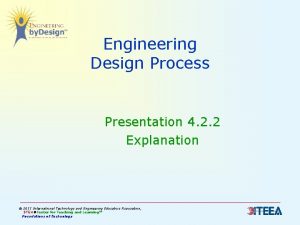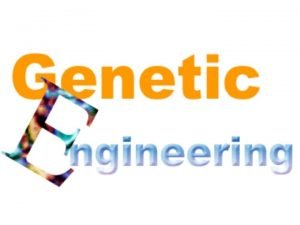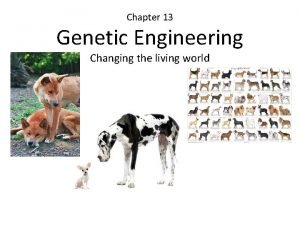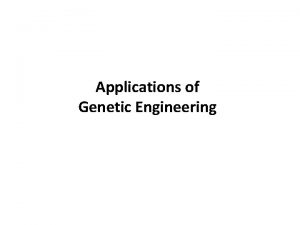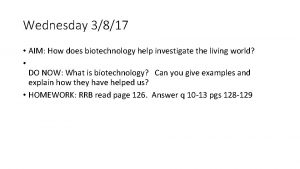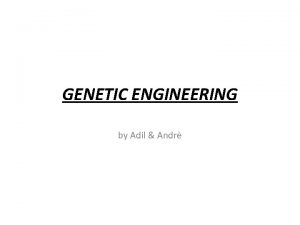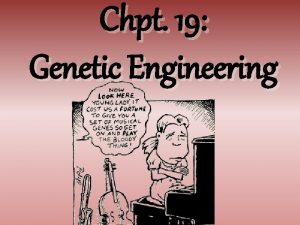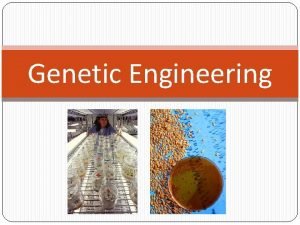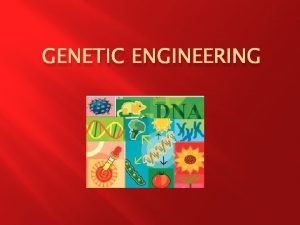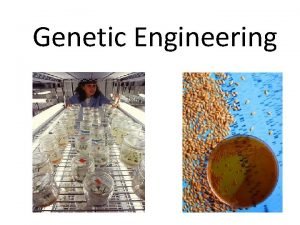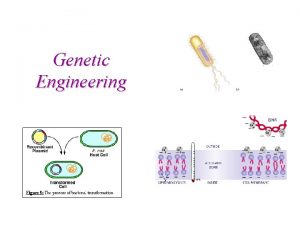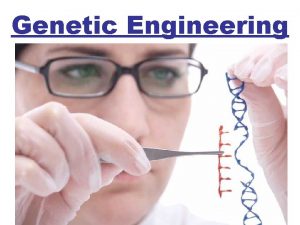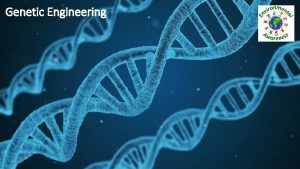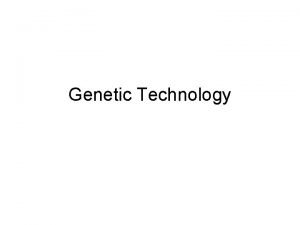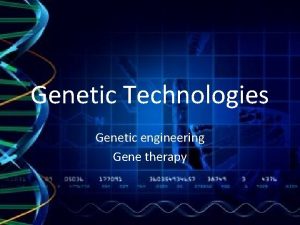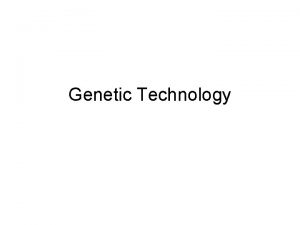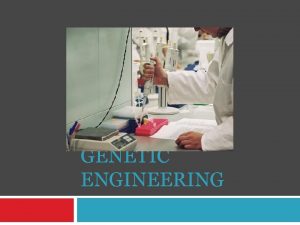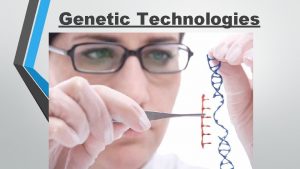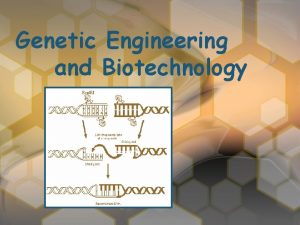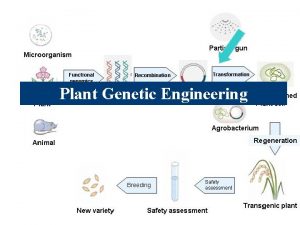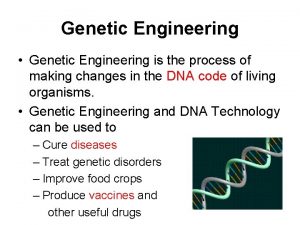Definition Genetic engineering refers to the scientific process

















- Slides: 17


Definition • Genetic engineering refers to the scientific process of manipulating genetic material. • It involves altering, replacing or transferring genes from one organism to another for some specific purpose. • Usually, genes are transferred to impart some characteristic of the source organism to the target organism.

Gene Isolation • In genetic engineering, a gene of interest is first identified and isolated from the thousands of genes an organism may have. • The isolated gene is then cut from its source DNA molecule with restriction enzymes and, using a vector virus or bacterium carrier, is transferred or blasted (with a gene gun) into a target DNA molecule.

Restriction enzymes • Restriction enzymes, also called restriction endonucleases, are enzymes that cut DNA at a specific nucleotide sequence. • Restriction enzymes are usually found in bacteria. They are extracted from them for use in genetic engineering.

Vectors • Vectors are genetic sequences derived from viruses or bacteria. They are used to move genes into the target cell. • A gene gun is a machine that offers one way of getting genetic material into cells.

Gene uptake • Most organisms have defence mechanisms to prevent foreign genes from affecting them. They can stop a foreign gene by blocking its ability to express itself. • This is known as gene silencing. To get around gene silencing, a promoter gene is added. It promotes the source gene in the target DNA and makes it more acceptable to the host cell.

Process of genetic engineering

Production of insulin

Gene identification • Insulin is a small protein. The gene coding for insulin is located using a gene probe and then isolated from the rest of the DNA in a human cell.

Gene isolation • The Eco. R 1 restriction endonuclease is used to cut the DNA into small pieces allowing individual genes to be isolated. • The enzyme cuts DNA between specific base sequences (G and A) which the enzyme recognises. • Most restriction enzymes split the strand in a staggered sequence. The unpaired bases at the cut form sticky ends.

Plasmid vectors • To get the gene into a bacterium a go-between or vector is used. The vector in this process is a plasmid (circular DNA found in a bacterium) from E. coli. • To obtain the plasmids the bacteria containing them are treated to dissolve their cell walls and the plasmids are separated from the cell remains.


Plasmid vector • The plasmid is cut using the same enzyme, restriction endonuclease. Once again, sticky ends are formed, allowing the donor DNA to be spliced into the vector DNA when the donor and vector DNA are mixed. • The sticky ends are complementary to each other, and can be joined together using DNA ligases. The DNA created is called recombinant DNA.

Marker genes • Marker genes that confer antibiotic resistance are included in the recombinant DNA forming the plasmids. • When the bacteria and plasmids are mixed together, only a small proportion of the bacteria take up the plasmids. • If the bacteria are then cultured on a growth medium treated with antibiotic, only those containing the plasmid with the marker will survive.

Manufacture • The genetically modified bacteria are cultured in a large scale using a fermenter and produce insulin which is then separated and purified. • Thus, human insulin can be used instead of extracting insulin from animals. Also large quantities of product are produced quickly and relatively cheaply.

Reverse transcription • Locating the correct piece of DNA is not easy as the cell contains only two copies of the DNA. Cells that produce large amounts of a particular polypeptide will have large amounts of m. RNA for that polypeptide. • If this m. RNA can be isolated, its complementary DNA (c. DNA) can be synthesised from it by a process called reverse transcription. This process is the reverse of normal transcription because the m. RNA acts as a template for DNA synthesis.

Reverse transcription • Reverse transcription requires DNA nucleotides and enzymes called reverse transcriptases. • After the m. RNA has been copied into its c. DNA, the m. RNA is removed and a second strand of DNA is made by adding the enzyme DNA polymerase and more DNA nucleotides. • The result is a doublestranded DNA molecule identical to the original DNA molecule.
 The founder effect
The founder effect Genetic programming vs genetic algorithm
Genetic programming vs genetic algorithm Genetic programming vs genetic algorithm
Genetic programming vs genetic algorithm A gene pool consists of
A gene pool consists of What is the difference between genetic drift and gene flow
What is the difference between genetic drift and gene flow Scientific method vs engineering design process
Scientific method vs engineering design process Scientific method vs engineering design process
Scientific method vs engineering design process Insulin bacteria genetic engineering
Insulin bacteria genetic engineering Section 13-1 changing the living world
Section 13-1 changing the living world Genetic engineering
Genetic engineering Genetic engineering steps
Genetic engineering steps Purpose of genetic engineering
Purpose of genetic engineering Genetic engineering conclusion
Genetic engineering conclusion Oryx and crake genetic engineering
Oryx and crake genetic engineering Genetic modification pros and cons in humans
Genetic modification pros and cons in humans Steps in genetic engineering
Steps in genetic engineering Bioluminescent genetic modification
Bioluminescent genetic modification Objectives of genetic engineering for class 10
Objectives of genetic engineering for class 10






